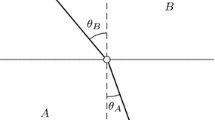Abstract
The planar point-objective location problem has attracted considerable interest among Location Theory researchers. The result has been a number of papers giving properties or algorithms for particular instances of the problem. However, most of these results are only valid when the feasible region where the facility is to be located is the whole space ℝ2, which is a rather inaccurate approximation in many real world location problems.
In this paper, the feasible region is allowed to be any closed, not necessarily convex, setS in ℝ2. The special structure of this nonconvex vector-optimization problem is exploited, leading to a geometrical resolution procedure when the feasible regionS can be decomposed into a finite number of (not necessarily disjoint) polyhedra.
Similar content being viewed by others
References
Brondsted, A. (1983),An Introduction to Convex Poly topes, Springer-Verlag, New York.
Carrizosa, E., Conde, E., Fernández, F., and Puerto, J. (1993), A Geometrical Characterization of Efficient Points in Constrained Euclidean Location Problems,Operations Research Letters 14, 291–295.
Chankong, V. and Haimes, Y.Y. (1983),Multiobjective Decision Making, North-Holland, New York.
Durier, R. and Michelot, C. (1986), Sets of Efficient Points in a Normed Space,Journal of Mathematical Analysis and Applications 117, 506–528.
Hansen, P., Peeters, D., and Thisse, J.F. (1982), An Algorithm for a Constrained Weber Problem,Management Science 28, 1285–1295.
Juel, H. and Love, R.F. (1983), Hull Properties in Location Problems,European Journal of Operational Research 12, 262–265.
Pelegrín, B. and Fernández, F.R. (1988), Determination of Efficient Points in Multiple-Objective Location Problems,Naval Research Logistic 35, 697–705.
Plastria, F. (1983),Continuous location problems and cutting plane algorithms. Ph.D. dissertation, Vrije Universiteit Brussel. Brussels.
Plastria, F. (1984), Localization in Single Facility Location,European Journal of Operational Research 18, 215–219.
Wendell, R.E. and Hurter, A.P. (1973), Location Theory, Dominance and Convexity,Operations Research 21, 314–320.
Wendell, R.E., Hurter, A.P., and Lowe, T.J. (1977), Efficient Points in Location Problems,AIEE Trans. 9, 238–246.
Author information
Authors and Affiliations
Rights and permissions
About this article
Cite this article
Carrizosa, E., Conde, E., Muñoz-Marquez, M. et al. Planar point-objective location problems with nonconvex constraints: A geometrical construction. J Glob Optim 6, 77–86 (1995). https://doi.org/10.1007/BF01106606
Received:
Accepted:
Issue Date:
DOI: https://doi.org/10.1007/BF01106606




